Conservation Principles for Wiring Lighting Systems
Bruce Kirk
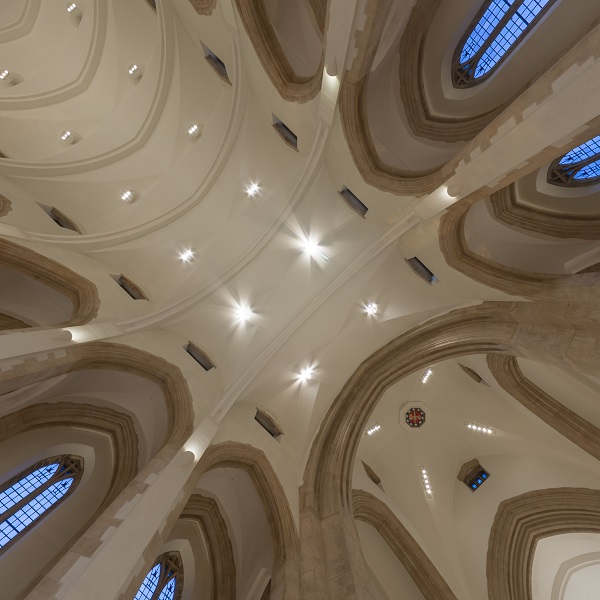 |
|
| Guildford Cathedral: the main lighting is provided by LED spotlights at 22m in bespoke housings suspended from exisiting hanging points. These provide general downlighting as well as accent lighting for liturgical points of focus and spotlighting for concerts and events. (Photo: Nikhilesh Haval, all other photos: Light Perceptions Limited) |
Two of the key goals of lighting and other electrical projects in historic buildings are to ensure that as much of the infrastructure as possible is unseen and that the level of intervention into the building fabric is managed and minimised.
Many important factors contribute to the project team’s ability to achieve these goals; some are visual and aesthetic while others, which are of equal or sometimes greater importance, relate to less visible aspects of the project such as the type and positioning of cables and fixings.
THE VISIBLE SIGNS
First and foremost, the lighting design must meet the overall needs of the project brief. There should be the correct levels of general illumination, which may differ for areas of circulation, reading and formal meetings. There should be highlighting for points of focus and the provision of general architectural enhancement to help visitors enjoy and interpret the building.
The choice of luminaire is critical to minimising the aesthetic impact of a new lighting installation. Irrespective of the optical power and performance of the fittings, their physical shape and size is likely to be the most obvious manifestation of the scheme. For example, a cylindrical shaped light fitting might be more appropriate near to the rounded shafts of a column than to a rectilinear pilaster. Similarly, square-edged fittings do not sit comfortably alongside curved architectural details.
Users also tend to be more accepting of the aesthetic impact of technology when they can see that it is serving a useful purpose, so light fittings appear less intrusive when they are lit than when they are off. For example, visitors will pay little attention to art gallery lighting which is obviously illuminating the artwork and improving the quality of their experience. The careful selection of louvres and other accessories is important in minimising glare and unwanted ‘stray’ light, further reducing the visual impact. Nonetheless, some luminaires are often seen when they are turned off and care should be taken to ensure that they look, as far as possible, appropriate to the space.
Another essential part of the design is that the controls must provide the level of functionality and flexibility required to meet the needs of the building’s various uses. This might just mean the correct switching arrangement but could involve a manual or pre-set dimming system.
WHAT LIES BENEATH
Beyond these visible attributes are the aspects that lie below the surface, or are otherwise out of view of building users and visitors. This is where it is necessary to consider how the installation of the fittings and all the associated electrical works can avoid or minimise interventions into historic fabric. The pre-planning phase of any lighting scheme should establish its feasibility and basic installation ground rules at the earliest opportunity.
In a new-build environment, designers would develop full 3-D models of a space including details of all potential service ducts and cable routes. Refurbishment projects in more modern buildings are normally informed by comprehensive operation and maintenance manuals or O&Ms which include as-built drawings of the current or past installations. However, projects in historic buildings rarely have such a well-informed starting point. The available drawings might be hand-drawn or digitised from archive material, and few buildings over 100 years old were designed with service ducts compatible with modern requirements.
As a result, when beginning work in a historic building it is often essential to commission a thorough, systematic investigation and on-site survey of the existing fixed wiring installation before the detailed design work starts. If as-built drawings exist they may be useful, provided they are checked for accuracy. This early enabling process will provide a clearer and more coordinated picture of what services and routes exist and where any new routes might be required.
Only once the investigations have taken place can any invasive work be considered and this should only be done with the intention of minimising other disturbance to the historic fabric. Pre-existing accessible voids, slots, holes and service routes must, wherever possible, be reused to minimise additional permanent scarring to the building. If new openings are absolutely necessary, then everything must be done to ensure that as many services as possible share a common route through the building. This will minimise the loss of historic fabric and, along with designing-in spare capacity, will ensure that further loss of building fabric is contained, in the short term at least. Any and all such routes must be approved by the architect or surveyor before any works commence.
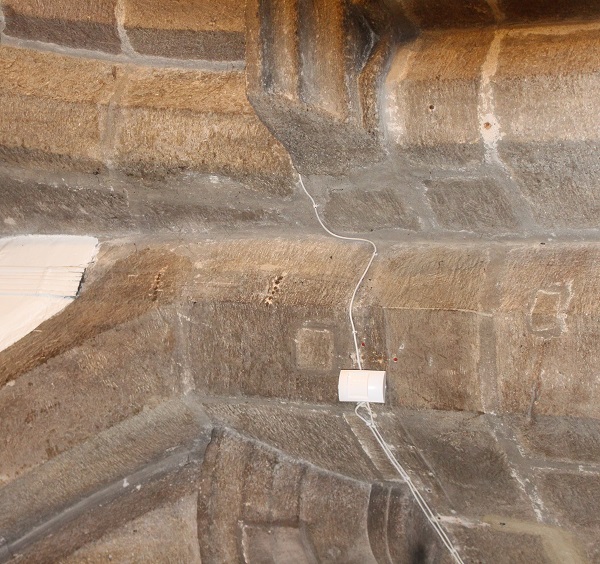 |
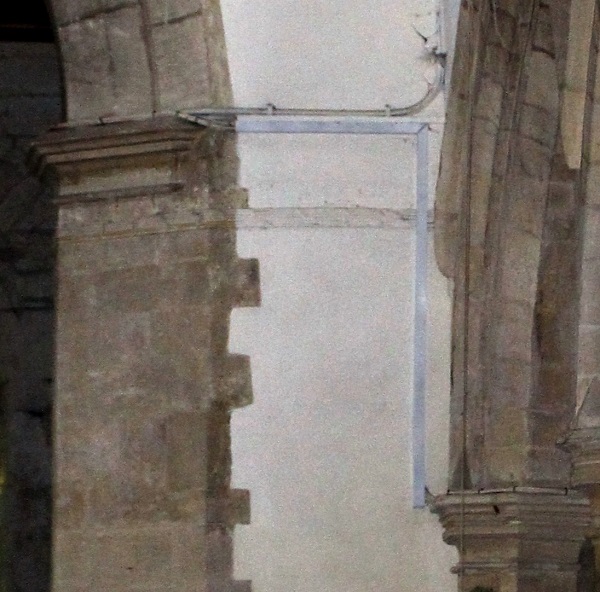 |
||
| These lead cables, redundant since 1975, have been cut back at the edge of the rendered area. Fixings remain in the stonework where the cables have been removed but the rendered wall surface would have been very badly damaged had all the cables been removed | Poor choice of cable route under an aisle ceiling: the junction box should have been fitted direct to the planking between the rafters with the cabling running along the top of the wall plate. | ||
 |
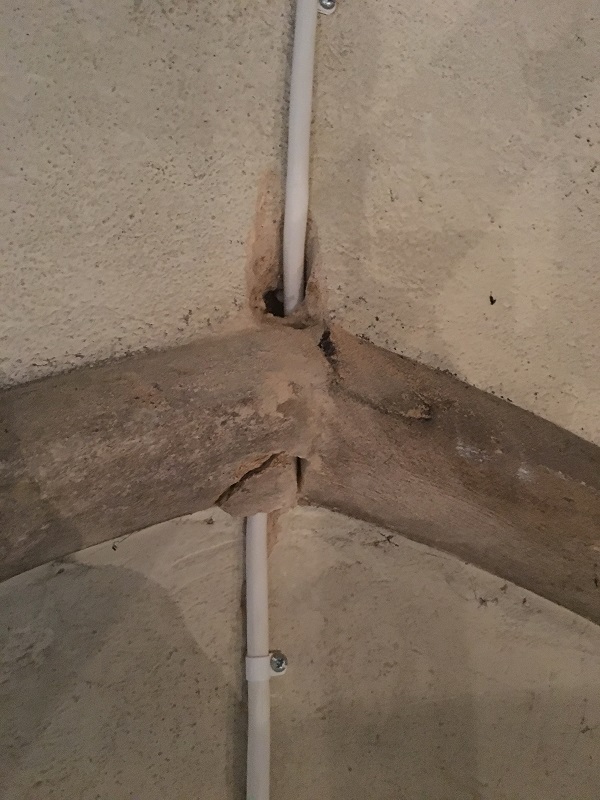 |
||
| A mixture of twin and earth, fire resistant cabling and plastic trunking running around the west arch of a medieval tower | An unfortunate route taken behind the hood mould of a window, damaging the stonework |
HIDING NEW CABLING
Where the building lends itself to offering suitable routes, a surface installation may sometimes be a viable solution, for example where mouldings, column capitals cornices or balustrades can disguise the presence of a carefully installed cable or conduit system. However, it is important to ensure that an installation of this type does not cover up, damage or otherwise interrupt the view of important building features and surfaces, nor should it create dirt traps or staining patterns from any resulting heat, moisture or air movement.
Again, all such routes must be preapprovedby the architect or surveyor. Visible cabling, clips, junction boxes and any containment should be painted to match the surface finish as closely as possible.
FIXINGS AND PATTRESSES
The fixing and positioning of cable clips and brackets are also important. Positioning must respect the building’s requirements on spacing, rather than simply adhering to manufacturer’s guidelines or industry standards. Fixings should be made into material that is sacrificial rather than permanent, such as the mortar joints in stone or brickwork. Rather than fixing cable clips or conduit saddles at rigidly measured intervals, it may be necessary to have an irregular pattern that follows the spacing of the stone courses or other joints. The use of pin clips or any other fixings installed with hammers is to be avoided in most cases. With all installations, intervention should be kept to a minimum and strict observance to the principle of reversibility should be adhered to. Cables should be secured with screws fixed into timber or plastic plugs wherever possible. This principle applies equally to the fixing of any component within a building services system. For example, a light switch or a fire alarm breakglass unit may need the additional help of a pattress box, or other secondary support system, to enable the device to be fitted in the required location while allowing the mortar joints (or other preferred fixing locations) to be used.
Timbers should not be drilled unless it is unavoidable, but at least such holes can be filled by wooden plugs or scarfing. The use of wood screws is far less damaging because their subsequent removal will leave less scarring and, if the screw did not remove any material in the first place, the timber will probably expand and refill the screw hole.
NEW OPENINGS AND OPPORTUNITIES
Where new openings into the fabric of a listed building are required, these will need to be very carefully considered, fully justified and discussed in detail with the architect or surveyor. The works may well need formal approval from statutory bodies too. If the work is in a church or cathedral then it will be under the jurisdiction of the relevant body such as the Cathedrals Fabric Commission, diocesan advisory committee (DAC) or historic churches committee (HCC).
Where normal listed building consent requirements apply then the conservation officer of the local planning authority should be consulted. Works in scheduled ancient monuments will of course require scheduled monument consent.Where any loss of historic fabric is inevitable, the investigative, opening up and reinstatement works should be taken as an opportunity to additionally survey, record and repair other services found. This can be an ideal opportunity to discover and record ancient artefacts or graffiti. During a recent project at St John’s College Cambridge, for example, a 300-year-old shoe was found in a wall after timber panelling had been removed to allow new emergency lighting cables to be installed. It is thought that the shoe was placed there to protect the Master of the College and its discovery provided valuable evidence of historic beliefs in ritual magic.
After suitable records were made, the shoe was replaced in its original position along with a time capsule from the present day.
BUILDERS' WORK
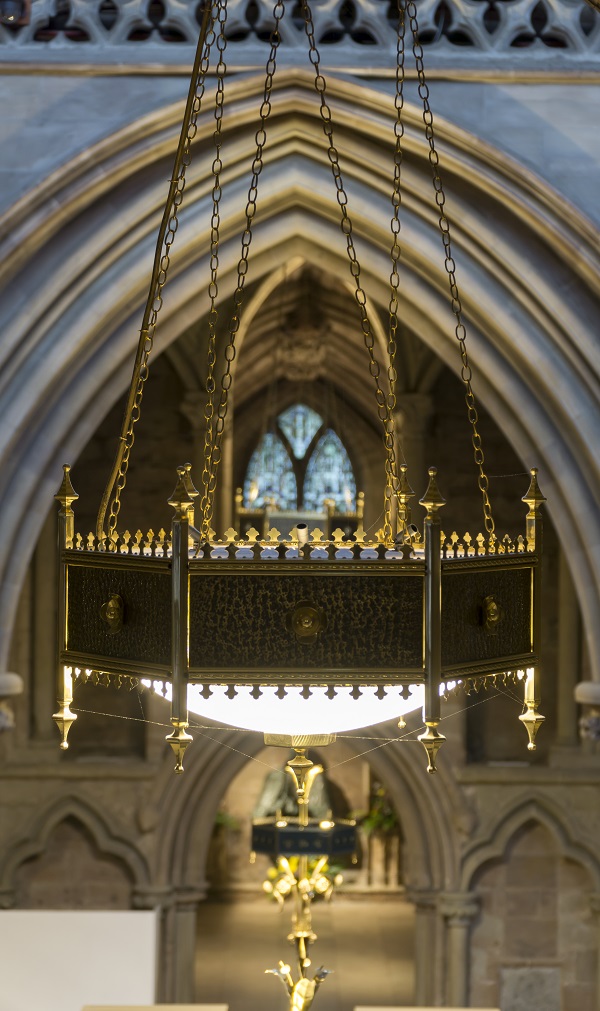 |
|
| One of 38 bespoke electroliers designed by Light Perceptions for Lichfield Cathedral. The design is informed by the work of Sir George Gilbert Scott and Francis Skidmore in the cathedral's crossing screen and pulpit. |
The nature of historic buildings demands that all builders’ works must be carried out with far greater care than in general construction work. Specialist contractors are the key to a more satisfactory outcome. This often means that it takes longer to remove, replace or renew any building services installation in a historic building. Service routes may need to be longer or more convoluted to accommodate the structure.
Where old services cannot be reused but retain a particular significance to the building, it is important to leave them in place. Equally, older or redundant services such as cables or pipework should not be removed if the removal is likely to cause further disruption to the historic fabric. This requires leaving them in an inert condition where services are disconnected, made safe or drained down and then recorded. Their removal should only be considered if they have no historic significance, the removal process is non-destructive, or if their retention might pose a future danger to the historic fabric, perhaps through rust or chemical deterioration.
A practical example of the benefits of retaining older systems is the reuse of redundant gas pipes as electrical conduits (it was the early reuse of old gas pipework that gave rise to the idea of steel conduits for wiring in the first place).
INSTALLING NEW CABLES AND RECONNECTING OLDER ONES
Good practice dictates that, wherever possible, new continuous cables should be used throughout an installation to minimise the number of cable joints or in-line terminations. This dramatically reduces the risk of termination errors as well as the risk of fire from thermal cycling, the overheating and arcing of loose terminations.
However, it may be necessary, for conservation reasons, to retain a buried cable or conduit if its wholesale removal and replacement would cause further unjustifiable damage to historic fabric. In this case it would be important to identify
the location of re-termination points and ensure future accessibility.
A comprehensive new lighting scheme at St Paul’s Cathedral was completed in 2007. As part of the initial investigative works, a significant number of existing heavy duty mineral insulated copper cables (MICCs) were tested. Installed in the late 1950s with an expected service life of 150 years, they were found to be in excellent condition and it was decided that they should be retained rather than replaced. Manufactured in the 1950s, the cable and its terminations were imperial rather than metric, so the main difficulty was in obtaining additional terminations for new joints. Eventually the contractors found a small stock holder and the modifications could take place with the older cables properly jointed to the new system.
A similar problem often occurs where imperial conduits are retained and need to be connected to new systems. Generally, where older installed cables are to be retained and reconnected as part of a new installation, or where any other new junctions are required, all such terminations should only be made in fixed junction boxes with fixed-back terminals such as DIN rail or other appropriate connectors. The risks of thermal cycling for all cable types and terminations must be considered and all terminations should be made in easily accessible and suitable locations which should be identified and shown on new record drawings. Termination schedules for all intermediate junction boxes should also be included in the O&M manuals.
CABLE TYPES AND CONTAINMENT
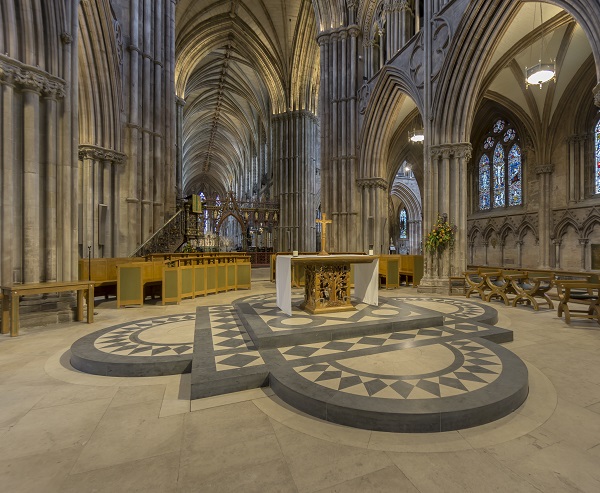 |
|
| The nave alter at Lichfield Cathedral, lit by pendants in the arcades and high level spotlighting from within the triforium. The pulpit and screen (by Scott and Skidmore) can be seen in the background. |
Installations in historic buildings should be designed to have the longest service life that can reasonably be achieved, particularly where new openings in historic fabric are required, or where a scaffold is needed. For this reason, the use of any PVC or plastic cable containment is to be discouraged.
For the majority of surface-fixed installations, MICC or ‘pyro’ cables should be used because they are more robust than almost all other normal cable types and are the most resistant to mechanical damage.
The use of other proprietary ‘fireresistant’ cabling for visible surface runs is not ideal because it is easily deformed by mechanical damage and does not normally dress as well as MICC around architectural mouldings and other details. However, fire-resistant cabling may be acceptable where it is not seen and is not at risk of mechanical damage.
Steel wire armoured (SWA) cable, with its protective steel binding, is generally bulkier than MICC or proprietary fire-resistant cabling and is commonly used for power distribution (for example as a sub-main to a distribution board). Ideally, it should always be hidden in service ducts and never used for visible final circuit cabling.
With all cable types, the method of surface fixing should be considered in respect of the surface as well as the cable type. Normally, ‘P’ clips will occupy less space than saddles and require only one rather than two fixings. However, where multiple cables are to run parallel to each other, a bespoke saddle may be a better solution. For SWA cables the normal cleats are excessively bulky and alternative strapping or saddles will have less visual impact.
Conventional containment such as trunking, cable tray and cable basket may be appropriate in unseen service ducts and roof voids, but is rarely acceptable if in view. Bespoke containment fabricated with timber cladding or decorative mouldings is often an excellent way of disguising cable runs where standard metal trunking would not be acceptable.
All cabling systems should be designed to avoid vulnerability to damage by rodents or other wildlife so any PVC cabling,
including final circuit wiring, should be in suitable containment. The risks to all cabling in roof voids, panelled walls and ceilings, or floor ducts should be fully assessed when the system is designed.
RECORD DRAWINGS
While a project may not have started off with a good set of record drawings, today’s standards and codes of practice require that every effort should be made to provide a thorough set of O&Ms. This is not only to provide every assistance to good maintenance in the future but is an important part of a building’s Health and Safety File.
THE ULTIMATE GOAL
Working in historic buildings is both challenging and stimulating. Since no two problems are quite the same, the solutions are rarely identical. Finding the right approach for each scenario can be difficult, especially when a project needs to satisfy multiple stakeholders, many with different agendas.The ultimate goal is to allow historic buildings to remain relevant and vibrant by implementing appropriate and reversible technical solutions which enhance their use. In effect, to achieve a thoroughly modern installation that is totally in harmony in a historic space.



